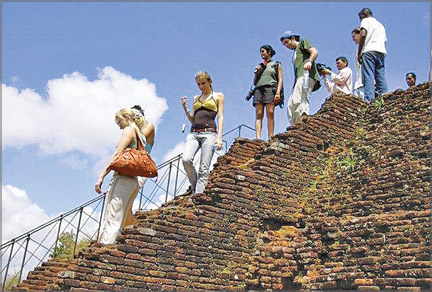Sri Lanka boom times
Two years ago, the LTTE were described by the
FBI as ‘the most dangerous and deadly terrorist organization in the
world.’
Christian A DeHaemer
Over the past 30 years, Tigers have killed over 100,000 people - the
vast majority of them civilians. The list of heinous acts is long and
multifaceted. Children were kidnapped and used as soldiers. The Tigers
sent more suicide bombers than other terrorist groups, far surpassing
the PLO. They even pioneered the use of suicide airplane attacks and
bomb belts.
|

Significant increase in tourist arrivals. File photo |
But on May 17, 2009, after being routed by the forces of Sri Lankan
President Mahinda Rajapaksa, the Tigers (or LTTE) finally admitted
defeat. The Tiger leaders were dead.
The war was over, and there were celebrations in the capital city of
Colombo.
The hub of South Asia
As I write this, Sri Lanka is undergoing a massive post-war
rebuilding boom.
They have deals in place with the International Monetary Fund (IMF)
which limits government spending and works toward a balanced budget.
This is a deal similar to the one made with South Korea and Indonesia
after their financial crisis in 1998.
South Korea’s Shares Index (EWY) went from 12 to 70 over the past
decade; the Indonesia’s Shares Index (PCX) went from 22 to 90 over the
past two years.
The IMF deal forces the politicians into fiscally conservative
governance, as well as gives them someone to blame for the austerity.
And in most cases, the IMF has a fine track record. (Argentina is a
notable exception.)

Sri Lanka has been on a major trade route between East Asia and the
Middle East for thousands of years.
Major trade route
It is most known for its tea, rubber, garments and tourism.
There is a new, deep-water port terminal being built in Colombo with
a $500 million investment from China Merchant Holdings.
The New York Times ranked Sri Lanka at the Number one out of 31 to
visit in 2010.
There will be several new business opportunities going forward in
real estate, business process outsourcing, banking, timber, pepper,
fisheries, education, health care, and infrastructure. In other words,
buy the hotels, cement makers and the banks.
For example, Seylan Bank Plc. (Colombo: SEYB) reported that profits
have risen 295 percent in the latest quarter.
The share price has tripled this year. The exchange as a whole is up
110 percent this year.
Last year, the Colombo Stock Index rose 120 percent - just edging out
Mongolia.
GDP growth
For most of the 2000s, GDP Growth in Sri Lanka was running at six
percent. In 2009, in the aftermath of the global bust, it contracted to
3.5 percent.
But so far this year - as the rebuilding gets underway and investors
flood into the market - GDP growth is running at 8 percent for the first
two quarters of 2010.
The IMF is projecting a seven percent growth rate in 2010, but will
soon revise higher.
IMF Mission Chief for Sri Lanka Brian Aitken said, “Our latest
projection came before the second quarter data and we would re-evaluate
our projections this November or December when the mission next visits
Sri Lanka. The second quarter growth was very positive and higher than
what we expected.” Sri Lanka has an income per head of US $ 4,500 which
is behind its neighbours (including the Maldives), but ahead of India.
In fact Sri Lanka has a more educated workforce, less bureaucracy and is
about half as expensive than India. And investors are flooding in.
Recently, Sri Lanka raised a billion dollars for 10 year government
bonds at 6.25 percent - lower than the 7.4 percent paid for a $500
million five-year issue last year. The offer was oversubscribed 6.3
times.
Buying the crisis
The biggest gains you can get from any market is after a crisis ends,
is resolved, or an era passes. This has been proven time and time again.

You’ve seen this in Colombia after the drug cartels. In Brazil, South
Korea, Russia, Indonesia, Kazakhstan, Mongolia, East Timor, Poland, New
Zealand and others.
Free government, free markets and an educated population coupled with
new hope equals a boom in equities.
The truth is that free trade and limited government have pulled more
people out of poverty than any other system and certainly more than any
well-intentioned welfare state program.
As fighting raged on, most foreign investors avoided Sri Lanka.
Competition was scarce.
Those investors who have been quick to move in over the past year
will benefit the most.
Tigers are dead
The CIA fact book estimated that the country has a GDP of $41
billion, with a purchasing power parity of $96 billion.
The market capitalization of the stock market is around $16 billion
with a P/E ratio of 25. This is a bit high compared to the rest of Asia
(India, for example, has an average P/E of about 12); but you have to
take into account the growth prospects.
I’m not a buyer - yet... But the country deserves watching.
Yesterday, market trading was halted after it fell five percent and
triggered safety switches. Last night, they traded down another 5.7
percent before closing in the green.
This is clearly a frontier market and not for the proverbial widows
and orphans.
That said, Sri Lanka is a place to put on your watch list.
Courtesy: Wealth Daily US |



